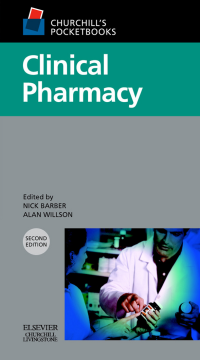
BOOK
Churchill's Pocketbook of Clinical Pharmacy E-Book
Nick D. Barber | Alan Willson | Ann Jacklin
(2006)
Additional Information
Book Details
Abstract
This title is directed primarily towards health care professionals outside of the United States. A comprehensive handbook of clinical pharmacy, it covers everything from the role of the pharmacist to key areas of practice such as OTC (over-the-counter) prescribing and therapeutic drug level monitoring. The new edition specifically addresses the changing role of the pharmacist in the community, issues surrounding compliance, management and communication skills, and more.
- This unique pocket-sized clinical reference is easy to use on the go.
- Includes content on both hospital and community pharmacy.
- How to Use This Book section at the beginning of the book helps readers get the most out of the text by describing all of its assets and their uses.
- Expanded and timely information on the changing role of the pharmacist in the community, including their role in initiatives such as smoking cessation, and protocols for emergency hormonal contraception.
- Includes more content on compliance such as researching and providing patients with accurate drug information.
- Expanded information on communication and management skills emphasize the importance of these skills for both community and hospital pharmacists.
- Improved, more user-friendly format features a two-color design to make finding information easier.
Table of Contents
| Section Title | Page | Action | Price |
|---|---|---|---|
| Front Cover | Cover | ||
| Clinical Pharmacy | iii | ||
| Copyright Page | iv | ||
| Contents | v | ||
| Contributors | vii | ||
| Preface | xi | ||
| Chapter 1. A philosophy of clinical pharmacy | 1 | ||
| Section 1: Policy | 7 | ||
| Chapter 2. Prescribing in primary care | 9 | ||
| Chapter 3. Clinical directorates and the role of the pharmacist | 19 | ||
| Chapter 4. Drug licensing and safety | 27 | ||
| Chapter 5. Evidence-based practice | 41 | ||
| Chapter 6. Pharmacoeconomics | 55 | ||
| Section 2: Choice | 69 | ||
| Chapter 7. The pharmacist as prescriber | 71 | ||
| Chapter 8. Pain | 81 | ||
| Chapter 9. Anti-infectives | 91 | ||
| Chapter 10. Smoking cessation | 109 | ||
| Section 3: Monitoring and management | 125 | ||
| Chapter 11. Medication error | 127 | ||
| Chapter 12. Prescription monitoring | 137 | ||
| Chapter 13. Primary care prescribing: practical approaches | 147 | ||
| Chapter 14. Improving adherence to medication | 155 | ||
| Chapter 15. Informing patients about the risks of their medicines | 163 | ||
| Chapter 16. Substance misuse | 171 | ||
| Chapter 17. Monitoring patients with renal disease | 187 | ||
| Chapter 18. Monitoring patients with liver disease | 211 | ||
| Chapter 19. Therapeutic drug level monitoring | 219 | ||
| Section 4: Reference | 229 | ||
| Chapter 20. Adverse reactions to drugs | 231 | ||
| Chapter 21. Insulins | 405 | ||
| Chapter 22. Intravenous drug administration | 409 | ||
| Chapter 23. Sodium content of injectable drugs | 425 | ||
| Chapter 24. Laboratory tests | 433 | ||
| Chapter 25. SI units for clinical chemistry | 463 | ||
| Chapter 26. Pharmacokinetics in clinical practice | 465 | ||
| Chapter 27. Comparative doses of corticosteroids | 477 | ||
| Chapter 28. Calculating body surface area from weight and height | 479 | ||
| Chapter 29. Abbreviations | 481 | ||
| Index | 485 | ||
| Laboratory Tests | 503 |
